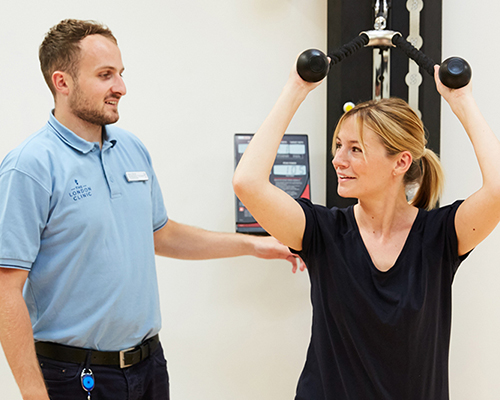
Wrist fractures
During a fall, it’s instinctive to reach out a hand out for protection or support, to regain your balance. The high impact of putting your entire body weight on your wrist coupled with the excessive hyper-movement at the wrist joint, can lead to fractures and/or ligament damage. Strengthening your upper limbs will reduce the risk of injury during a fall.
You can do this with a series of exercises including; press ups – on your knees or in a plank position, making sure that your engage your core muscles; grip strengthening – using a squeeze ball or hand grip strengthener; and wrist flexion and extension over the edge of a table – using light dumbbells, or resistance bands.
If you injure your wrist it’s crucial to stop and seek medical assistance. Depending on the severity of the injury, you may only need a splint or cast for the fracture to heal, but for more severe injuries, referral to a consultant and physiotherapist may be necessary.
Skier's thumb
This acute injury often happens when falling with your hand in the ski pole strap. The thumb becomes caught and pulled away from the palm of your hand, which can sprain or tear the ulna collateral ligament.
To help prevent this happening, try squeezing your thumb and fingers in towards each other – with your hand flat out on table; pushing and holding your thumb into a squeeze ball as hard as you can; and opening and closing your fingers and thumb to open up your web spaces.
If you experience pain, swelling, bruising, catching or instability at the base of the thumb, then it is important to seek medical review. This can result in difficulty with gripping, pinching and writing. Initial treatment is often with a cast or a splint known as a thumb spica, to allow the ligament to heal, before working on re-gaining range of movement, strength and stability with a hand therapist.
Shoulder dislocation
Fifty-two per cent of shoulder injuries on the slopes are anterior shoulder dislocations. This is when the upper end of the arm bone (humerus) is forced out of the shoulder socket (glenoid), usually as a result of a collision, or fall on the slopes.
Commonly, the arm is forced backwards, meaning that the head of the humerus shifts forward rapidly, causing subluxation or full dislocation of the soft tissue structures that hold the shoulder in place.
Surrounding the shoulder are four main stabilising muscles, known as the rotator cuff. These muscles help to keep the shoulder centred in its socket but they become weak after injury. It’s important to strengthen the rotator cuff after injury, as well as the larger muscles around the front of the shoulder.
To strengthen the shoulder try side planks - leaning on your elbow, or with your elbow out straight for more of a challenge; rotator cuff strengthening, using a resistance band by resisting rotation and abduction (arm away from your body); and controlled chest presses laying on your back with dumbbells, bar or weights machine.
In the case of injury the shoulder may be visibly out of the joint, meaning that careful relocation of the shoulder is necessary by a medical professional. Further tests are then carried out to rule out bony injury, or significant soft tissue disruption.
Treatment at The London Clinic
If you sustain any of the above injuries, whether you were on the slopes or not, why not come and see one of our physiotherapists who can put you on the road to recovery, as soon as possible.
Disclaimer
Any views expressed in this article are those of the featured specialist(s) and should not be considered to be the views or official policy of The London Clinic.